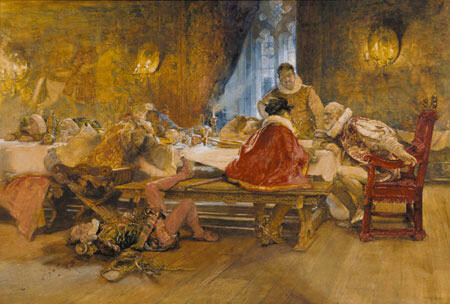Edgar Bundy
British, b.1862, d.1922
Conspirators
- c. 1910
- Watercolour
- Presented by the Canterbury Society of Arts, 1932
- 660 x 995mm
- 69/546
Tags: animals, benches (furniture), candles, chairs (furniture forms), curtains (window hangings), feasts, goblets, hats, history paintings, horses (animals), men (male humans), people (agents), plates (dishes), sconces, stained glass (material), swords, tables (support furniture), tapestries, windows, wine
In Conspirators Edgar Bundy depicts a purely imaginary scene in a Tudor banqueting hall where all but three of the company have succumbed to drugged wine. The conspirators are plotting their course of action. It is a typical example of Edwardian history painting, full of narrative detail and careful historical references in the costumes, architecture and furnishings. Bundy specialised in painting historical and genre works in oil and watercolour. He was influenced by the writings of John Ruskin (1819 -1900) who championed Venetian Gothic and held medieval art in high regard. Bundy was born in Brighton in 1862. He studied in the studio of Alfred Stevens at an early age but otherwise had no formal training. He exhibited at the Royal Academy from 1881 and at the Paris Salon from 1907. He was made an Associate of the Royal Academy in 1915 and went on to become a member of the Royal Institute of Painters in Watercolour and the Royal Society of British Artists.
Edgar Bundy painted many works which illustrated events in English history and the vicissitudes of the monarchy in the fifteenth and sixteenth centuries. The early fifteenth century in particular was a time of intrigue when many plots were hatched in an attempt to restore who some considered to be the rightful sovereign.
In this painting Bundy depicts a purely imaginative scene where all but three of a company of a banquet have succumbed to drugged wine. As dawn breaks the conspirators are still plotting their course of action.
The artist Edgar Bundy was born at Brighton and although largely self taught he did spend time at a very early age in the studio of Alfred Stevens. He began exhibiting at the Royal Academy, London in 1881 and continued to do so up until the last years of his life. From 1907 he also was a regular exhibitor at the Paris Salon.
